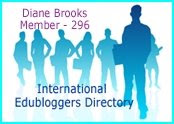Saturday, May 31, 2008
The Mystery Curriculum
Tuesday, May 27, 2008
Classroom blogs

Sunday, May 25, 2008
APA referencing

Wednesday, May 21, 2008
Convert flv files to another format
I found a great program - Super © v.2008 - it is freeware and works like a dream.

I have made a flash movie to explain how to use this software and have embedded it into a PowerPoint presentation which is uploaded into my resources black box (left hand side of this blog). When it first appears you will just see a blank slide - it will play when you play the slide show (go to Slide show on the menu bar and down to View show). Feel free to use this.
Tuesday, May 20, 2008
Mindmaps and critical thinking
Twardy, C. R., (2004). Argument Maps Improve Critical Thinking Teaching Philosophy, 27:2
This is very interesting although is discussing a particular piece of software to create argument maps his main thrust can be applied to other software that does similar things. At first he was sceptical about whether the use of argument maps indeed improved critical thinking skills but...
He found that students needed practice and that the three major components are argument mapping, quality practice, and scaffolded, structured learning.
I suspect that many teachers using mindmapping software do not use it as fully as it is intended but just as a quick brainstorm. Many of these packages have templates to help teachers to use them to encourage higher order thinking skills."Practice is clearly important: argument mapping without practice would not much improve critical thinking. Likewise, clear structure and expectations will improve any subject. Nevertheless, I suspect that argument mapping is the key — that if a traditional critical-thinking class matched the amount of practice and graduated structure of the Reason!(software package) method, it would not show the same level of improvement." (p.13)
Monday, May 19, 2008
Community Engagement in Education

Dr Cheryl Doig facilitated a CPPA workshop in Engaging the Community in Curriculum. Notes from the day have been uploaded to a wiki. This is wiki available for anyone to use as it does not have a password. Cheryl has uploaded files in here which suggest ideas for:
- engaging parents and the wider community
- student engagement
- using technology to enhance community engagement
- engaging with diversity
Sunday, May 18, 2008
Voice thread
Lookybooks
Click on the pages to turn them. What a great activity for children both in the classroom and at home. Only problem is that you can't take it to bed! (unless you are using a laptop etc)
Thursday, May 15, 2008
E-portfolio
 I love this site! In here are answers to questions about e-portfolios, the rationale for using e-portfolios, links to Web 2 tools, and some fantastic examples of e-portfolios made by some Year 8 students - and the reflections by the students (see an example of one below). What these children are doing is fantastic and it is easy to see how much learning is going on while they are working on their e-portfolios.
I love this site! In here are answers to questions about e-portfolios, the rationale for using e-portfolios, links to Web 2 tools, and some fantastic examples of e-portfolios made by some Year 8 students - and the reflections by the students (see an example of one below). What these children are doing is fantastic and it is easy to see how much learning is going on while they are working on their e-portfolios."I believe that teachers should make the change from worksheets and excercise books, to technology and teaching computer literacy. Our parents and teachers are the last generation to choose whether or not they will be computer literate, and if they chose to not be, their students will be unprepared, for the future. Children and teenagers nowadays have to be computer literate. Almost every occupation and career will require skill and knowledge, to do with using computers.
Almost every student I know, prefers using computer programs to complete excercises and activities. The days of activity sheets, excercise books and textbooks are over. We ALL should make the switch to computers today!"How long before some teachers do listen? - it is great to see that this teacher is the one who motivated these children.
Wednesday, May 14, 2008
Animoto
I have been playing around with Animoto to see how it works and then think how it could be used in a classroom. It is a great Web 2 tool which can be used in the classroom in any curriculum area. To use the free part of the site you first need to register. You are able to make full length (cost involved) videos or free short movies.
The short free video involves uploading 10 digital images, selecting music (the site has music available to you can upload your own) and then letting Animoto do the rest! No two videos are the same so it is possible for children to upload the same graphics and have a different video. The videos can then be seen in Animoto or you can see them in YouTube or embed into your own classroom web site (or blog etc).
This video was made using photographs taken of the children at Star of the Sea in Sumner, Christchurch, when they were having an ICT conference.
There is an educational area where teachers can go. Teachers are able to get an educational account so that they can now create longer than 30 second videos for free and download them for playing and keeping on your computer. To get this from Animoto use this link and email Rebecca for an educational registration key before you register.
Tuesday, May 13, 2008
Bio-cube and other Web 2 tools
 Bio-Cube (Web 2) is a great tool to use in the classroom. This can be used in different curriculum areas when students are exploring about the lives of famous people or to create a cube about themselves (a great idea at the beginning of the year).
Bio-Cube (Web 2) is a great tool to use in the classroom. This can be used in different curriculum areas when students are exploring about the lives of famous people or to create a cube about themselves (a great idea at the beginning of the year).After placing their name on the opening screen (to begin) students fill in 6 areas to create the cube which is then printed out. These can be put together to make a cube and displayed in the room as a mobile. A very effective tool.
 Bio-Cube is only one of the interactive tools to support literacy that you can find a ReadWriteThink. You will also find lesson/unit plans to use each of the tools. There is a comic strip creator, acrostic poetry, Venn diagram creator to name a few.
Bio-Cube is only one of the interactive tools to support literacy that you can find a ReadWriteThink. You will also find lesson/unit plans to use each of the tools. There is a comic strip creator, acrostic poetry, Venn diagram creator to name a few.One that those who do not have Inspiration or something similar is the Webbing Tool where students can make a mind map to print out.
"The Webbing Tool provides a free-form graphic organizer for activities that ask students to pursue hypertextual thinking and writing. The tool provides a quick way for students to trace out options and rearrange connections. Students can use the Webbing Tool to analyze readings as well as a prewriting activity and flowcharting tool. Students can drag the circle or box shapes representing their ideas to arrange any layout and relationship that they want. Each layer on the chart will have a different color border for the shapes that you choose."
Wednesday, May 7, 2008
"Whatever!" Mark Treadwell

"Education is in the throes of the greatest paradigm shift ever experienced . . . ever! As a consequence of this paradigm shift, how we view education and its role in the community is set to dramatically change within a very short time span. This transition is initiating a global “second Renaissance” which will power economies and societies for the next 100 years. This paradigm shift allows learners new flexibility and capabilities, providing a simple underlying architecture for innovation and ingenuity via the provision of rich information and communication environments via the internet. Within this new environment educators and learners can instantly create dynamic learning communities within which learning transitions from knowledge, to developing understanding and then applying that understanding with wisdom." (Treadwell, 2008)
Monday, May 5, 2008
Rich Tasks

In the first part you will find
- What is a rich task?
- Why are they necessary?
- Behind the rich task, setting up a thinking culture
- The BIG picture
In the second part is about developing a powerful learning context
The third part is 'rich tasks and powerful learning'
The fourth area is 'putting it all together'
It has many interesting resources about rich tasks available on this wiki.
Thursday, May 1, 2008
Scratch

Scratch is developed by the Lifelong Kindergarten group at the MIT Media Lab, in collaboration with the UCLA Graduate School of Education and Information Studies, with financial support from the National Science Foundation, Intel Foundation, and MIT Media Lab research consortia.

 Web site: http://ictineducation.webege.com/
Web site: http://ictineducation.webege.com/









